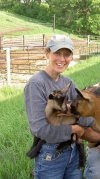 On March 3, Joel Salatin came to M State and gave two speeches: one in the afternoon, and one in the evening. I had the honor of picking him up at the airport the night before with my friend Tony; it was a truly exciting experience.
On March 3, Joel Salatin came to M State and gave two speeches: one in the afternoon, and one in the evening. I had the honor of picking him up at the airport the night before with my friend Tony; it was a truly exciting experience.Tony and I had to pick Joel up at the airport in Fargo. We got there early and sat down at a cafe. We both had a hankering to get something -- coffee or soda or a snack -- but we didn't because we were nervous about what Joel Salatin might think if he saw us with our disposable cups filled with a food product grown by conventional agriculture and shipped half-way around the world.
I had drawn a sign for Joel with little farm animals so he would recognize us as his ride. We recognized Joel right away, although we were a bit surprised to see him in a suit instead of overalls and a straw hat. It seemed this was Joel-the-professional-speaker, not Joel-the-farmer.
Soon enough we discovered that despite the fancy clothes, Joel was the Joel we knew from the books and movies: smooth-talking, full of energy, and passionate about sustainable agriculture. We tried not to pester him with too many questions in the car (although there was so much we wanted to ask him) and play it cool. But the conversation inevitably drifted from small talk to sustainable farming, and soon I found myself inquiring about his method of killing rabbits.
That evening, we joined Joel for dinner downtown Fergus Falls and drove him back to his hotel afterwards. The following morning, we got to pick him up and take him to M State. We were Joel's un-official chauffeurs, and it was wonderful!
Joel spent the morning with our class answering our questions, and then we had a potluck lunch. All of us had been so nervous making food for Joel Salatin, but we needn't have been: he was a grateful guest and praised our food.
That afternoon, M State had a decent crowd in Legacy Hall ready to listen to Joel speak. Joel did a fantastic job both inspiring and provoking the audience; at one point he said he would like to abolish the USDA, but he admitted that was never going to happen and suggested that we should just abolish all subsidies instead. At the end of his speech, he got a standing ovation from everyone but the farmers who receive big subsidies.
Thursday evening, Joel gave a different speech outlining the six key components of a local food system. Once again, some people were upset -- a few walked out. But most of the audience was enthralled.
One of the best parts of the experience was getting to introduce Joel Salatin before both of his speeches. Yes, indeed -- I got to introduce Joel Salatin! I remembered the introduction given to Wes Jackson at the Prairie Festival; his introducer said he felt like a math teacher introducing Sir Isaac Newton. Now I really felt where he was coming from. Here I was, a city girl with less than one year of experience in the SFP program, and I was introducing THE Joel Salatin!
I can't do justice to his speeches by summarizing them here. Instead, I will wait until they are posted on youtube and post a link. Let me just say that if you have never heard of Joel Salatin, you should look him up. Better yet, read one of his books. I'd suggest starting with "Holy Cows and Hog Heaven." Or you may want to wait for his new book coming out this fall, "Folks, This Ain't Normal."

